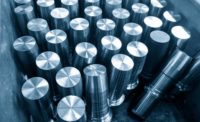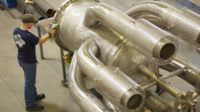Handheld XRF (HHXRF) is the go-to tool for QA/QC, alloy identification and failure analysis of incoming and in-use standard industrial metals and alloys. Advancements in technology and data analysis software now make it an indispensable tool for non-standard and challenging QA/QC situations. For instance, they are now used
- to inspect powder for sintered metal used in 3D printing
- to manage the quality of miniature alloy components in consumer products
- to classify rare earth magnet materials
- and even to determine the production floor source of tiny metal contaminant fragments found in food product manufacturing.
Primary advancements in HHXRF which make non-standard and challenging alloy QA/QC applications possible include the following:
- New X-ray source and detector technology provide improved sensitivity for lower detection limits of lighter elements, such as Mg, Al and Si at low levels. Improved measurement geometry, along with new X-ray tubes and detectors, provide better accuracy and precision to meet tighter tolerance specifications of metals and alloys used in critical applications.
- Advancements in collimation and internal camera technology enable improved positioning of small samples of interest within the XRF excitation beam, such as miniature alloy components and contaminant fragments found in food product manufacturing.
- Improved construction of HHXRF housings with IP54 ingress protection rating protects the analyzers from dust and water, enabling their use in harsh manufacturing environments.
- Improved software algorithms, compensating for different sample forms and sizes, ensure that the same calibration used for a large alloy piece works just as well on small parts, slivers and powders.
- Sintered Metal Powder in 3D Printing
Direct metal laser sintering (DMLS) using additive manufacturing (AM) requires quality assurance of end products and incoming metal powders. This rapidly evolving process is used for critical aerospace, automotive, defense and medical applications. Optimal HHXRF sample presentation involves placing powders in an XRF sample cup with thin XRF film and using a desktop stand with the nose up for reproducible testing. The same calibrations for large metal alloy pieces can be used on metal powders when HHXRFs incorporate new software to compensate for variations in alloy form.
Miniature Alloy Components in Consumer Products
Miniature alloys used in consumer products, such as vaporizers for e-cigarette and cannabis use, require strict QA/QC. This is for safety and performance reasons as well as for verifying monetary value of the selected model. Pen or portable vaporizers are priced on their use of 300 series stainless steel for heat sources, Nichrome® or Kanthal® for coil based heaters, and grade 1 or 2 titanium for temperature control of coils and heaters. HHXRFs with new software which compensates for the various sizes and shapes of these miniature alloys make it as straightforward a process as QA/QC of large alloy pieces. New HHXRF instruments can pinpoint the sample spot with an integrated camera and small sample spot collimator for precise analysis of miniature components.
Rare Earth Magnets
Rare Earth (REE) magnets are made by placing raw materials, such as Nd or La, with other elements such as Fe, B, Al, Nb, Co or Cu, into a furnace to create an alloy. The newly made alloy is broken down into a very fine powder and then pressed in the presence of an applied magnetic field. These powerful magnets are used in a variety of applications such as wind turbine generators, hard disk drives, and headphones. Quality procedures are required for acceptance of raw material as well as inspection, sorting, and recycling of the REE magnets. Modern HHXRF technology with higher 50keV excitation voltage, along with new software features, enables accurate analysis of the REE raw materials and magnets.
Metal Contaminants in Food Product Manufacturing
Contaminants found in food are frequently quite small, typically chips or slivers. Optimal sample presentation involves placing the fragment on thin XRF film atop an XRF sample cup and using an HHXRF desktop stand with the nose up for accurate and reproducible testing. Most handheld XRFs already contain alloy libraries for identification of a metal contaminant. However, in order to determine the source of a contaminant, an XRF audit of all equipment on the production floor must be performed. The composition of the foreign body can then be matched with the source, either by alloy ID matching or by advanced spectral fingerprint matching software.
Micro Alloyed Steels
Micro alloyed steels are a family of steels strengthened by the addition of small alloying concentrations to low-carbon steel. Automakers and other industries are replacing conventional steel with advanced high strength steels to improve safety and fuel efficiency. Micro alloyed steels contain small amounts of alloying elements, including Nb, V, Ti, Mo and Zr, to refine grain microstructure and facilitate precipitation hardening. Measurement of these micro-alloying elements requires excellent accuracy and precision which was not possible with HHXRF until the recent advancements in X-ray source and detector technology. Modern HHXRF is now able to provide accurate chemistry and trace analysis for these steels to ensure the correct level of micro alloying elements.







